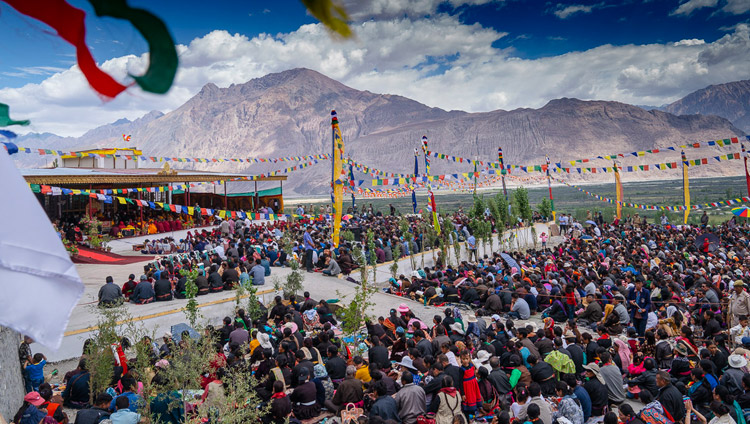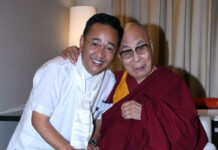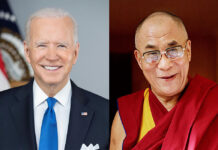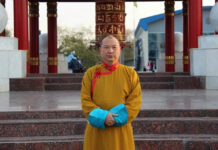
(TibetanReview.net, Jul14, 2018) – Some 5,600 devotees attended the Dalai Lama’s religious teaching given Jul 13 on the teaching ground next to the Diskit Phodrang in the Nubra area of Jammu & Kashmir state’s Ladakh region. The Dalai Lama is visiting the region till Jul 21 as a monsoon getaway and to give religious teachings, having arrived there sometime in the beginning of this month.
Those who received him included his host, former member of Rajya Sabha (Upper House of Indian Parliament) Thiksey Rinpoche, as well as former Ganden Throneholder Rizong Rinpoche, besides many others.
He led a session on the generation of the awakening mind of bodhichitta, something he said he practiced himself daily, and also gave guidance on meditating on emptiness. Copies of the texts of his teaching were made available in Tibetan, English and Chinese languages in keeping with the requirement for the assorted crowd of devotees.
He said: “We have five sensory consciousnesses, but it’s the sixth, mental consciousness, that holds the key to pain or joy. We can enjoy watching beautiful and captivating events, listen to moving music, smell pleasing fragrances, taste delicious food or revel in the pleasure of touch, but if we compare these sensory experiences with peace of mind, the mental experience is stronger and more lasting.”
“As a follower of the Buddha, belonging to the Nalanda Tradition,” he was stated to have continued, “as people who have undertaken study, contemplation and reflection, I feel we should have a concern for all human beings, since we all seek happiness.”
He has also said that for achieving happiness, material development alone is not enough. “Inner values like love and compassion are crucial too. These are related to methods for transforming the mind that have grown from the common Indian practices of shamatha, cultivating a calmly abiding mind, and vipashyana, which involves developing wisdom and insight.”
He has explained that the text ‘Praise of Dependent Arising’ praises the Buddha not for his physical qualities but for his having taught dependent arising. In relation to the ‘Four Noble Truths’ and so on, the Dalai Lama introduced the concept of causality as illustrated by the twelve links of dependent arising. “These start with ignorance and end with aging and death. Ignorance enmeshes us in unenlightened existence, but to overcome it leads to liberation.”
Explaining the purpose of looking for the reality of things, the Dalai Lama has thus quoted Nagarjuna’s observation: “Through the elimination of karma and mental afflictions there is liberation; karma and mental afflictions come from conceptual thoughts and these come from mental fabrications. Fabrication ceases through emptiness.” The point, he said, is to eliminate distorted views that give rise to disturbing emotions.
He has pointed out that when Nagarjuna’s Middle Way School of Thought asserts that things do not exist truly, it means they do not exist as they appear, that is, as something that is intrinsically existent. “‘Praise of Dependent Arising’ begins by lauding the Buddha as an unparalleled teacher because of his instructions about dependent arising—that things are not independent but exist merely as designated.”
The Dalai Lama has explained that realization of emptiness contributes to the accumulation of wisdom while cultivating altruism contributes to the accumulation of merits. “Since these ultimately result in the two bodies of a Buddha, it’s important to reflect on them daily.”
The Dalai Lama was stated to have been joined for lunch by representatives of Muslim communities in Ladakh’s Turtuk, Bogdang and Nubra areas.





